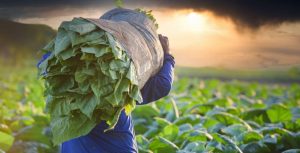
Are you curious about what goes on at a tobacco farm? From planting to harvesting, there’s much more to it than meets the eye.
Tobacco farming has a rich history and tradition that spans centuries. From the early days of colonial America to the present day, tobacco has played a significant role in the economy and culture of many regions around the world.
The art and science of growing tobacco involves careful attention to detail and a deep understanding of the plant’s needs. From selecting the right seeds to nurturing the plants through each stage of growth, tobacco farming requires skill and expertise.
A day in the life of a tobacco farmer is filled with hard work and dedication. From planting to harvesting, there is always something to be done on a tobacco farm. But despite the challenges, many farmers find great satisfaction in their work.
Running a successful tobacco farm requires a strong understanding of economics. From managing costs to maximizing profits, tobacco farmers must be savvy businesspeople in order to thrive.
The future of tobacco farming is uncertain, with many challenges and opportunities on the horizon. From changing consumer preferences to new regulations, tobacco farmers must be prepared to adapt and innovate in order to succeed.
Tobacco farming plays an important role in many local communities. From providing jobs to supporting local businesses, tobacco farms are often an integral part of the local economy.
The global impact of tobacco farming is significant. From its role in international trade to its impact on the environment, tobacco farming has far-reaching consequences.
The culture and heritage of tobacco farming are rich and diverse. From traditional methods passed down through generations to new innovations and techniques, tobacco farming is an ever-evolving art form.
Tobacco farming is a complex and fascinating subject with a rich history and tradition. Despite the challenges facing the industry, tobacco farmers continue to work hard to produce high-quality products for consumers around the world.
Statistics:
According to the USDA, tobacco farms in the United States averaged only 62 acres of harvested cropland and 175 acres of total farmland. Total sales from tobacco farms averaged $41,816. Sixty-two percent of tobacco farms were owned by their operators, 29 percent were partly owned, and 9 percent were rented or leased (https://naldc.nal.usda.gov/download/38941/PDF).
FAQs:
What is tobacco farming?
Tobacco farming is the process of growing and harvesting tobacco plants for use in various tobacco products.
2.
Where is tobacco farming most common?
Tobacco farming takes place primarily in low- and middle-income countries (LMIC) (https://tobaccotactics.org/wiki/tobacco-farming/).
3.
What are some of the challenges facing tobacco farmers?
Tobacco farmers face many challenges, including changing consumer preferences, new regulations, and decreasing prices for tobacco leaf (https://tobaccotactics.org/wiki/tobacco-farming/).
4.
How does tobacco farming impact the environment?
Tobacco farming can have negative impacts on the environment, including deforestation, soil degradation, and agrochemical pollution (https://tobaccocontrol.bmj.com/content/21/2/191).
5.
What role do multinational tobacco companies play in tobacco farming?
Multinational tobacco companies’ policies and practices contribute to environmental problems related to tobacco leaf production (https://tobaccocontrol.bmj.com/content/21/2/191).
6.
What are some alternative livelihoods for tobacco farmers?
Alternative livelihoods for tobacco farmers may include transitioning to other crops or industries.
7.
How does tobacco farming impact local communities?
Tobacco farming can play an important role in local communities by providing jobs and supporting local businesses (https://tobaccotactics.org/wiki/tobacco-farming/).
8.
What are some common agricultural practices related to tobacco farming?
Common agricultural practices related to tobacco farming include selecting the right seeds, preparing the land, and nurturing the plants through each stage of growth.
9.
How does tobacco farming impact human health?
Tobacco farming can negatively impact human health through loss of ecosystem services, including land resources, biodiversity, and food sources (https://tobaccocontrol.bmj.com/content/21/2/191).
10.
What is the future of tobacco farming?
The future of tobacco farming is uncertain, with many challenges and opportunities on the horizon.
11.
How does contract growing work in the tobacco industry?
The contract growing system keeps farmers impoverished and dependent on tobacco companies and their leaf sourcing affiliates for seeds, agrochemicals, and pricing (https://tobaccotactics.org/wiki/tobacco-farming/).
12.
How does the price of tobacco leaf affect farmers?
The price of tobacco leaf affects farmers’ profits and their ability to make a living from growing tobacco.
13.
What role do government subsidies play in tobacco farming?
In some countries, government subsidies may be necessary for small-scale production of tobacco to be profitable (https://tobaccotactics.org/wiki/tobacco-farming/).
14.
How does the diversity of agroecosystems affect the resilience of tobacco farmers?
Tobacco farmers who manage less diverse agroecosystems may be more vulnerable than non-tobacco growers of the same area (https://tobaccotactics.org/wiki/tobacco-farming/).
15.
What role do women play in tobacco farming?
Women play an important role in many aspects of tobacco farming, including planting, harvesting, and processing.
Books:
“Tobacco: Growing, Curing, and Manufacturing; A Handbook for Planters in All Parts of the World” by C.G. Warnford Lock (https://www.amazon.com/Tobacco-Growing-Manufacturing-Handbook-Planters/dp/1528476123)
“Any Road: The Story of a Virginia Tobacco Farm” by Connie Ellison (https://www.amazon.com/Any-Road-Story-Virginia-Tobacco/dp/059540202X).
Sources of information:
Some sources of information on tobacco farming include academic journals such as Tobacco Control (https://tobaccocontrol.bmj.com/content/21/2/191), websites such as TobaccoTactics (https://tobaccotactics.org/wiki/tobacco-farming/) and Statista (https://www.statista.com/topics/1593/tobacco/), government organizations such as the USDA (https://naldc.nal.usda.gov/download/38941/PDF), and books such as “Tobacco: Growing, Curing, and Manufacturing; A Handbook for Planters in All Parts of the World” by C.G. Warnford Lock (https://www.amazon.com/Tobacco-Growing-Manufacturing-Handbook-Planters/dp/1528476123).
Citations:
(https://tobaccocontrol.bmj.com/content/21/2/191): Environmental health impacts of tobacco farming: a review of the literature | Tobacco Control
(https://tobaccotactics.org/wiki/tobacco-farming/): Tobacco Farming – TobaccoTactics
(https://naldc.nal.usda.gov/download/38941/PDF): Trends in U.S. Tobacco Farming – USDA
(https://www.statista.com/topics/1593/tobacco/): Tobacco industry – statistics & facts | Statista
(https://www.amazon.com/Tobacco-Growing-Manufacturing-Handbook-Planters/dp/1528476123): Tobacco: Growing, Curing, and Manufacturing; A Handbook for Planters in All Parts of the World (Classic Reprint): C. G. Warnford Lock: 9781528476126: Amazon.com: Books
(https://www.amazon.com/Any-Road-Story-Virginia-Tobacco/dp/059540202X): Any Road: The Story of a Virginia Tobacco Farm: Ellison, Connie: 9780595402021: Amazon.com: Books